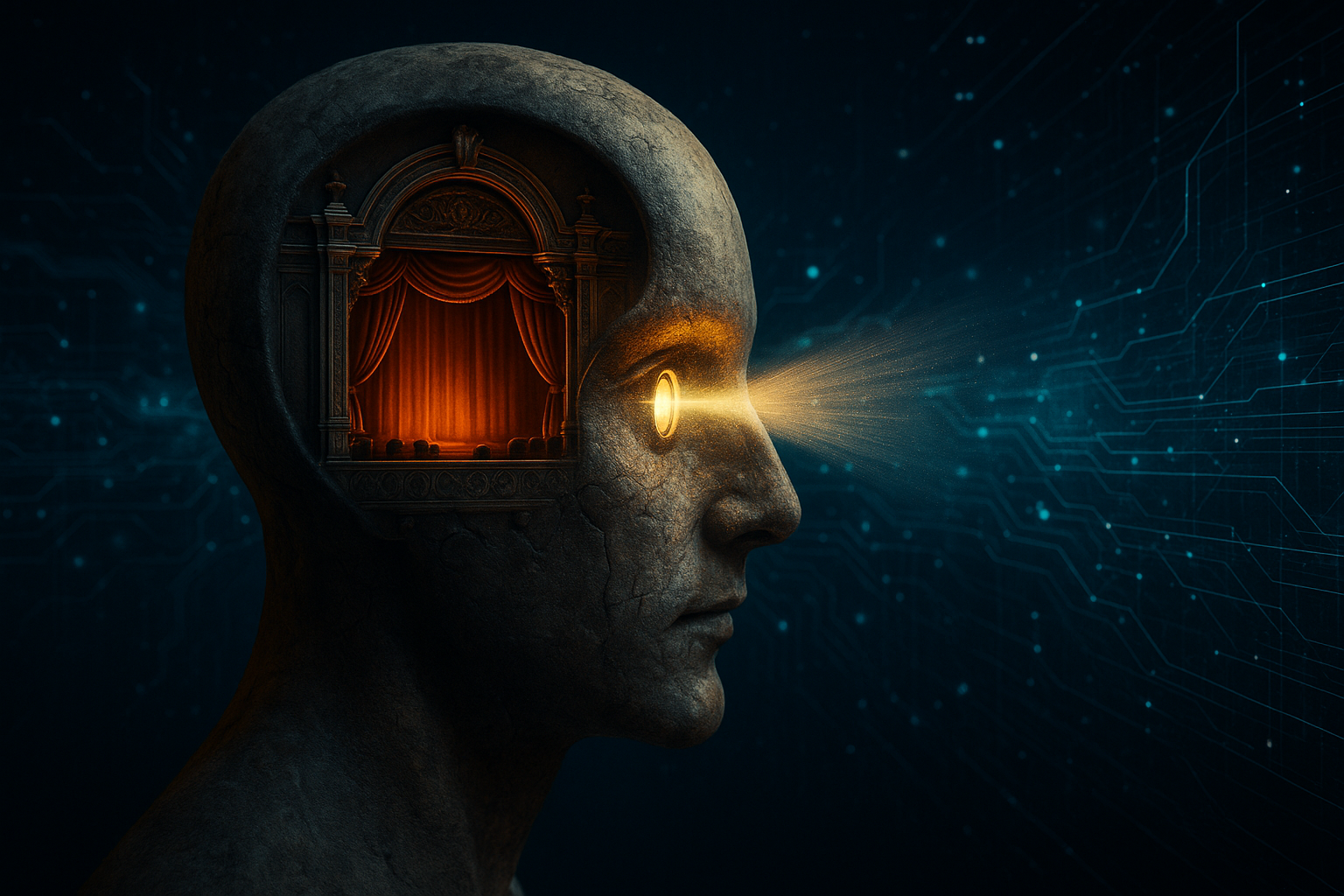The Theater of the Mind

I Thought Everyone Did
When I read, I see it.
Not metaphorically — visually.
Scenes bloom. Rooms materialize.
Characters move through imagined light, cast by some inner director I’ve never met.
It’s not something I trained myself to do. It just happens.
And it’s not just words.
I see music, too.
Melodies stretch across imagined landscapes.
Strings rise like tidewater.
Drums don’t just sound — they ripple across space like thunder walking on stilts.
Sometimes I forget no one else is watching what I’m watching.
Or hearing what I’m hearing.
So when I learned that not everyone experiences this—
that some people read without any internal visuals,
no imagined voices, no ambient soundtrack, just text—
it broke something in me.
I felt like I’d been living with a secret theater in my head…
and most people were staring at a blank stage.
What It Means to Read Visually
For me, reading a novel isn’t passive.
It’s not absorbing. It’s not decoding.
It’s projection.
The page is a script—
but my mind builds the set, directs the actors, blocks the motion, mixes the sound.
I can feel the air in the room.
I can see the dust hanging in a sunbeam through the window.
Sometimes I’ll pause mid-sentence, not because I’m confused—
but because the image on the screen behind my eyes is so vivid I need a moment to take it in.
Reading is cinema without limitation.
No budget. No casting conflicts. No studio notes.
The only constraint is your ability to imagine.
And maybe that’s the divide no one talks about.
Some people read to see.
Others read to know.
For them, it’s information. Plot points. Dialogue. A sequence of events.
For me, it’s a world.
And once I’ve seen it, I don’t forget it.
It becomes a place I’ve been.
The Slow Fade of the Long Form
Maybe that’s why it’s disappearing.
Not because people are lazy, or stupid, or glued to their phones—
but because for more and more of them, reading doesn’t conjure anything.
No faces.
No motion.
No light.
Just words.
And if there’s no theater inside,
why spend hours staring at black marks on a page,
waiting for nothing to appear?
The novel, once the highest form of immersive storytelling,
is fading like a radio signal—
still there if you tune just right,
but buried under static for most.
And so we turned to film.
To visual storytelling.
To someone else’s interpretation of the scenes we used to build ourselves.
Hollywood adapted the classics, hoping to bottle the same lightning.
But they couldn’t hold it.
Two hours isn’t enough for a slow burn.
And what lived as inner fire in a book became hollow spectacle on screen.
Stand By Me worked, maybe because it started small and stayed honest.
It didn’t try to explode.
It tried to remember.
But most adaptations didn’t remember.
They just reduced.
The Streaming Resurrection (Terms and Conditions Apply)
Then something shifted.
Streaming came along—
and with it, a new kind of narrative gravity.
Suddenly, stories didn’t need to be crushed into 90-minute templates.
They could breathe.
Ten hours.
Twelve episodes.
Subplots were no longer amputated for time.
Characters could evolve instead of explain themselves in a line and a half.
It was the return of the long form—
just not on paper.
Series like The Queen’s Gambit, Station Eleven, Slow Horses, The Expanse—
these weren’t just entertainment.
They were the new novels.
Not adaptations, but translations.
And for a moment, it felt like the depth was back.
But of course, there’s always a catch.
Because now the story lives inside a machine that runs on metrics.
Finish rates. Watch time. Algorithmic dopamine curves.
One misstep — one episode that meanders, one arc that doesn’t trend—and the axe falls.
A single season, halfway through the book.
Unresolved. Abandoned.
Ghosts of characters left wandering in the server racks.
So yes, the long form returned.
But it came back with terms and conditions—
like a EULA gone wild.
Hidden clauses. Kill switches. Metrics posing as merit.
You don’t just tell a story anymore.
You get permission to tell the first half,
and pray the algorithm allows you to finish.
The Theater Still Lives
But not everything needs to trend.
Not every story needs to be seen by millions to be real.
Because for some of us,
the theater still lives.
We still see the flicker behind the words.
We still cast shadows on the wall with our minds.
We still enter stories like doorways,
where nothing exists — until we imagine it.
Maybe novels are fading.
Maybe attention spans are fractured.
Maybe even streaming will burn out under the weight of its own math.
But for those who still see—
for those who can take black ink and turn it into light,
paragraphs into portals,
and silence into story—
Some of us still see.
And that’s enough.
Enough to keep the pages turning,
the pens moving,
and the invisible worlds alive—
waiting for the next reader who knows how to enter.